
WEIRD FOOD NEWS
09/18/20 — Ada Broussard
Hello! You made it to Friday, and for your reward we’re sharing some food news we’ve harvested from across the internet. Some of it’s salty, some sweet, and most of it is arguably not very important. But entertaining? Yes! It’s entertaining. As a small farm, we interact with just a tiny sliver of the food system including a modest number of restaurants, a handful of local grocery stores, and of course directly with our wonderful customers, most of whom live in the same city in which we farm. Our vegetables get their start and their finish all within our localized food system and Austin-based supply chain. For this reason, it’s easy to forget about the very weird and wide world of food that exists beyond our rows of kale local delivery routes . But that doesn’t mean this news isn't interesting to us. So this week, we thought we share the weird food stories that we're reading and wondering about.
![]() The original watermelon ham was conceived at Ducks Eatery in New York City. Photo taken from their Instagram.
The original watermelon ham was conceived at Ducks Eatery in New York City. Photo taken from their Instagram.
![]() Photo courtesy of The Atlantic. The experimental archaeologist Farrell Monaco uses ancient Roman baking techniques to re-create classic breads, such as the panis quadratus.. Photo by FARRELL MONACO.
Photo courtesy of The Atlantic. The experimental archaeologist Farrell Monaco uses ancient Roman baking techniques to re-create classic breads, such as the panis quadratus.. Photo by FARRELL MONACO.
![]() Photo from the original article, as seen in Mordern Farmer.
Photo from the original article, as seen in Mordern Farmer.
![]() Photo courtesy of C4/LOVE PRODUCTIONS/MARK BOURDILLON
Photo courtesy of C4/LOVE PRODUCTIONS/MARK BOURDILLON
![]() Pepsi's new sleep aid drink is called Driftwell.
Pepsi's new sleep aid drink is called Driftwell.
![]() Mosa Meat "clean" hamburger MOSA MEAT
Mosa Meat "clean" hamburger MOSA MEAT
![]() The display at Central Market Westgate is beautiful! Just look at those pots swimming in habaneros!
The display at Central Market Westgate is beautiful! Just look at those pots swimming in habaneros!
![]() It's so fun to see our branded boxes displayed so prominently! Makes us very proud! Thanks, Central Market!
It's so fun to see our branded boxes displayed so prominently! Makes us very proud! Thanks, Central Market!
![]() At Central Market on Lamar, there is this very cute cartoon of Farmer Brenton. How do we know it's him? It's wearing the Brenton uniform! Denim shirt and green JBG hat.
At Central Market on Lamar, there is this very cute cartoon of Farmer Brenton. How do we know it's him? It's wearing the Brenton uniform! Denim shirt and green JBG hat.
1. "Hot Watermelon is Unlikely. That Doesn’t Mean it’s Wrong."
Here at the farm, we eat watermelon raw. Sometimes, it’s still warm with field heat garnered from the sun... but this isn’t the type of hot watermelon this article is talking about. Apparently, people are taking the juicy fruit and turning it into smoked hams. And burgers. And steaks. If this sounds like you’re thing, by all means fire up the smoker, set aside 8+ hours, and let us know how it goes. Watermelon ham how-to video here, full article about hot watermelon here.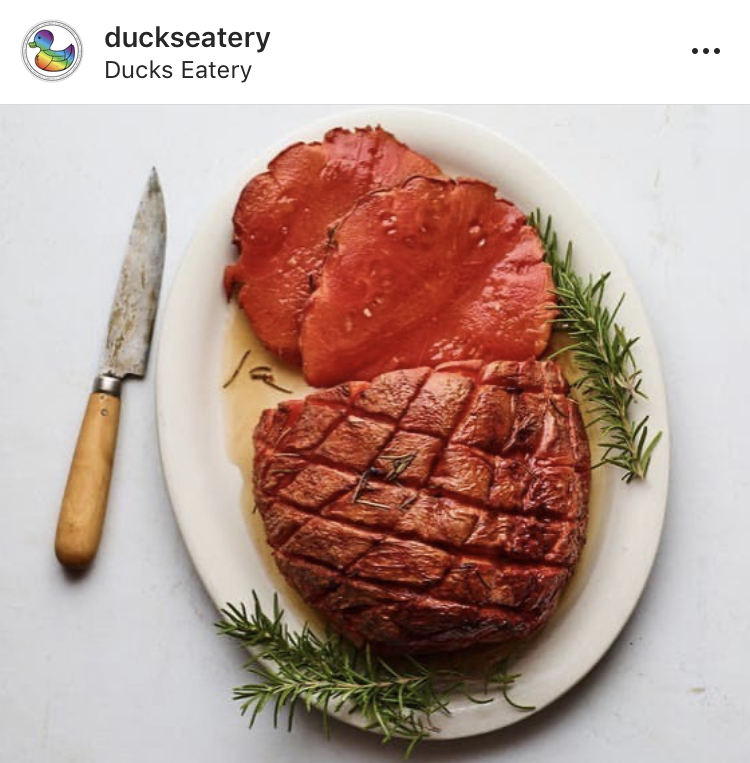 The original watermelon ham was conceived at Ducks Eatery in New York City. Photo taken from their Instagram.
The original watermelon ham was conceived at Ducks Eatery in New York City. Photo taken from their Instagram.
2. "How an archaeologist and the creator of the Xbox brought an ancient Egyptian sourdough starter back to life."
Seamus Blackley, best known for creating the Xbox, took the quarantine sourdough craze to a new level when he baked a loaf of bread using 4,000 year old yeast extracted from chambers buried underneath the temple of Pharaoh Mentuhotep II. Seamus wasn’t the only archaeologists exploring ancient baking methods during quarantine, and there were even online classes where you could learn to bake like a 1st century Roman. Read the full story here. Photo courtesy of The Atlantic. The experimental archaeologist Farrell Monaco uses ancient Roman baking techniques to re-create classic breads, such as the panis quadratus.. Photo by FARRELL MONACO.
Photo courtesy of The Atlantic. The experimental archaeologist Farrell Monaco uses ancient Roman baking techniques to re-create classic breads, such as the panis quadratus.. Photo by FARRELL MONACO.
3. "Painting Eyes on Cows’ Butts Can Scare Away Predators"
How could we not include this click bait article from Modern Farmer? The headline, and the butt eyes, pretty much say it all. Photo from the original article, as seen in Mordern Farmer.
Photo from the original article, as seen in Mordern Farmer.
4. "I’m Surviving Quarantine by Cooking Gourmet Stoner Food for My 5-Year-Old Why my new kitchen mantra is #StonerFoodsOfTheApocalypse."
Okay, this isn’t really a news story, but we really loved this essay by Ivy Pochoda about how she’s cooking her 5 years old anything she wants, which happens to be lots of resourceful and creative combinations of ingredients. “while others are peddling black-market sourdough starter, proofing croissants, and making their own everything bagels, I’ve taken a track that provides immediate gratification, goofy joy, and has ushered in an era of peaceful meals.” See all the stoner food, here.5. "A New Season of ‘The Great British Bakeoff’ Is Coming This Month."
Are you a seasoned fan of this hit British baking show? Or perhaps you’ve never heard the declaration to “Ready, Set, Bake”! Either way, you should check out this new season of delightful home-bakers as they happily kneed and proof for the esteemed title of Star Baker. Apparently, this season was filmed during the pandemic and contestants and crew were in a baking bubble, which undoubtedly smelled of warmed cinnamon and buttery yeast rolls. Photo courtesy of C4/LOVE PRODUCTIONS/MARK BOURDILLON
Photo courtesy of C4/LOVE PRODUCTIONS/MARK BOURDILLON
6. "In 2020, Soda Is A Sleep Aid & Water Is Caffeinated, Because Of Course"
Two new products (and types of products) hit the shelves this week: soda that will put you to sleep, and water that will keep you up. Apparently, coffee and plain ole’ H20 aren’t doing the trick for consumers who are both anxious and sleepy all at once. Pepsi's new sleep aid drink is called Driftwell.
Pepsi's new sleep aid drink is called Driftwell.
7. "Is Cultured Meat The Answer To The World's Meat Problem?"
Promises of technology that can produce cultured meat isn’t exactly breaking news, but it’s weird food news, to be sure. Through this process, meat is grown using animal cells, not in a barnyard but in a high-tech laboratory. The first lab-grown burger was made in 2013, with the meat costing an estimated $1.2 million per pound. Advances in the production process are happening every day, and researchers hope that eventually the technology will catch up enough to create a lab-burger that rivals a regular (?) burger in price. But what about taste? Read the full story here. Mosa Meat "clean" hamburger MOSA MEAT
Mosa Meat "clean" hamburger MOSA MEAT
8. "Costco’s Wine Advent Calendar Is Back And Features Wine From All Over The World"
Somehow, we’ve reached that moment in the year when store windows and grocery shelves begin to hint at the holidays to come. Costco developed a wine advent calendar that features wines from all over the world, and apparently it was a smash. For those of you eager to begin your holiday shopping (ha!), get thyself to Costco before this best-seller is sold out.9. "A.I. Robot Serves Customers At Seoul Restaurant."
“A trolley-like robot is delivering food to customers at a restaurant in Seoul, in order to minimize human contact and help ensure social distancing.” Yep. You need see this robot in action for full the full Jetson experience. Full story and video here.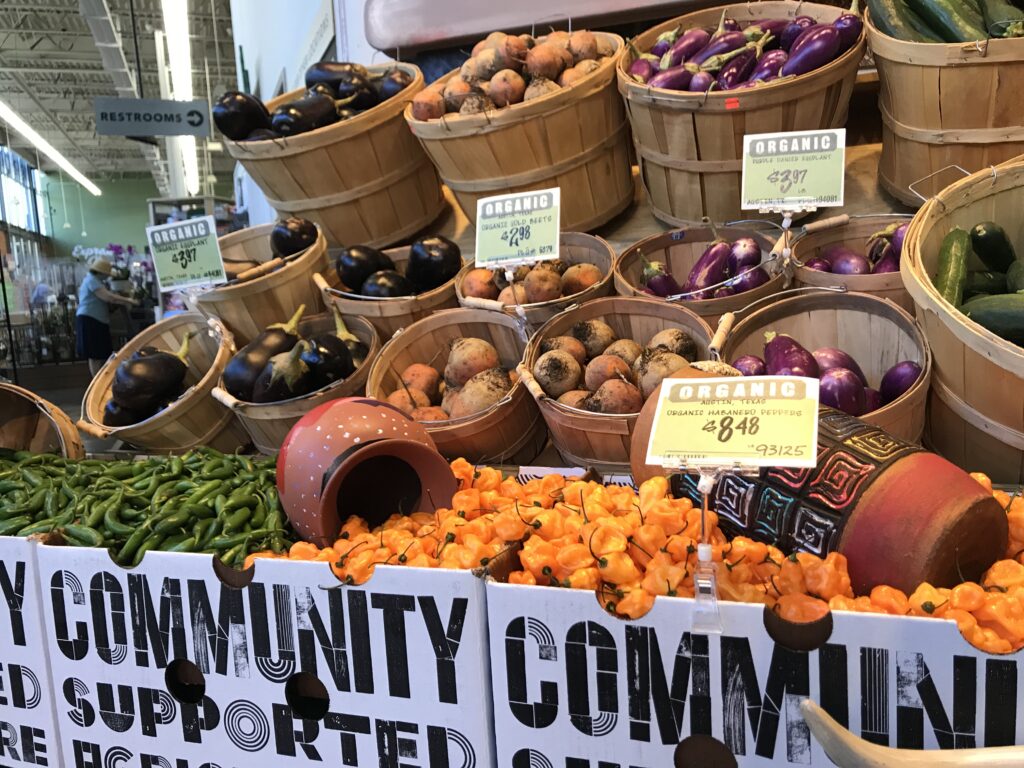 The display at Central Market Westgate is beautiful! Just look at those pots swimming in habaneros!
The display at Central Market Westgate is beautiful! Just look at those pots swimming in habaneros!
10. Central Market Presents Home Sweet Home Grown: Texas Farmers Market Week Sept. 16 - Oct. 6
Well, we couldn't help but include some local news that isn't necessarily weird, but does involve our veggies :) Central Market is currently running a special on our produce as a part of a two week promotion featuring Texas-made products. Both the Westgate and Lamar locations have beautiful displays of JBG produce including current crops like eggplant, habaneros, zucchini, beets, and more. It really feels like a farmers’ market in there, and there are tons of Texas-made and grown products to marvel. We first delivered veggies to Central Market in 2010 - about five cases of product. Over 10 years later, and Central Market has grown into one of our best grocery partners. We usually deliver upwards of 50 cases a week! Both the Westgate and Lamar locations in Austin regularly carry JBG produce, but the current selection is a stunner! Checkout the beautiful displays below! We can’t tell you how exciting it is for us to see our vegetables and our branded boxes displayed so prominently and beautifully at a local grocery store.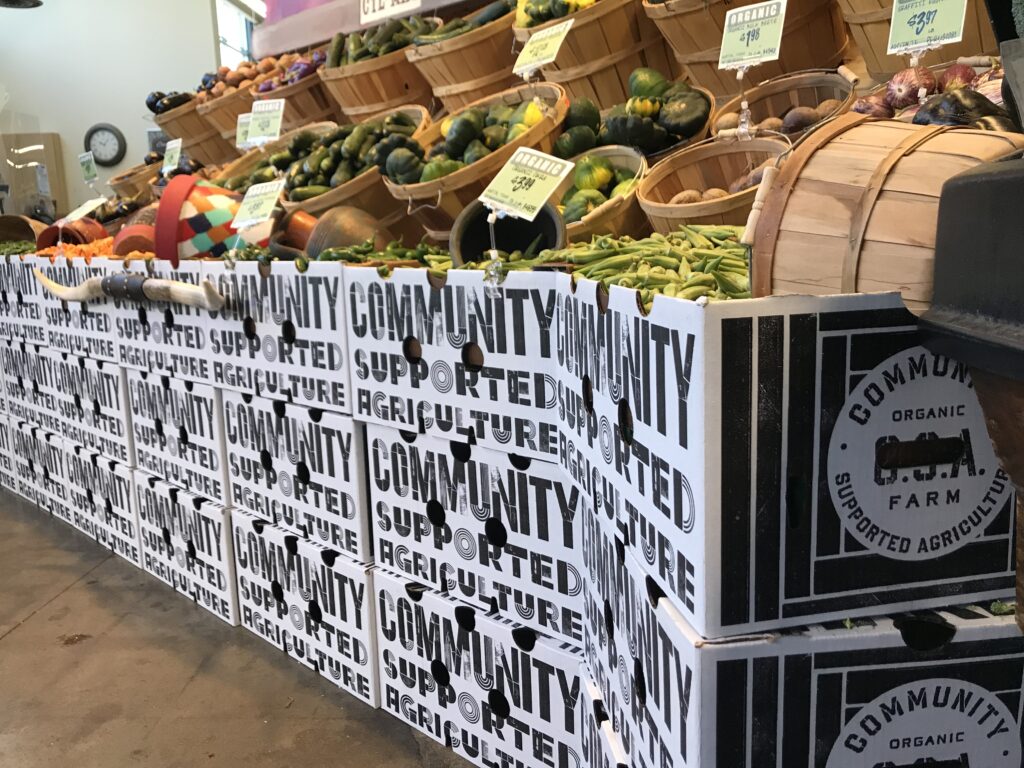 It's so fun to see our branded boxes displayed so prominently! Makes us very proud! Thanks, Central Market!
It's so fun to see our branded boxes displayed so prominently! Makes us very proud! Thanks, Central Market!
 At Central Market on Lamar, there is this very cute cartoon of Farmer Brenton. How do we know it's him? It's wearing the Brenton uniform! Denim shirt and green JBG hat.
At Central Market on Lamar, there is this very cute cartoon of Farmer Brenton. How do we know it's him? It's wearing the Brenton uniform! Denim shirt and green JBG hat.
OTTOLENGHI'S EGGPLANT WITH GARLICKY BUTTERMILK YOGURT SAUCE
09/17/20 — Ada Broussard
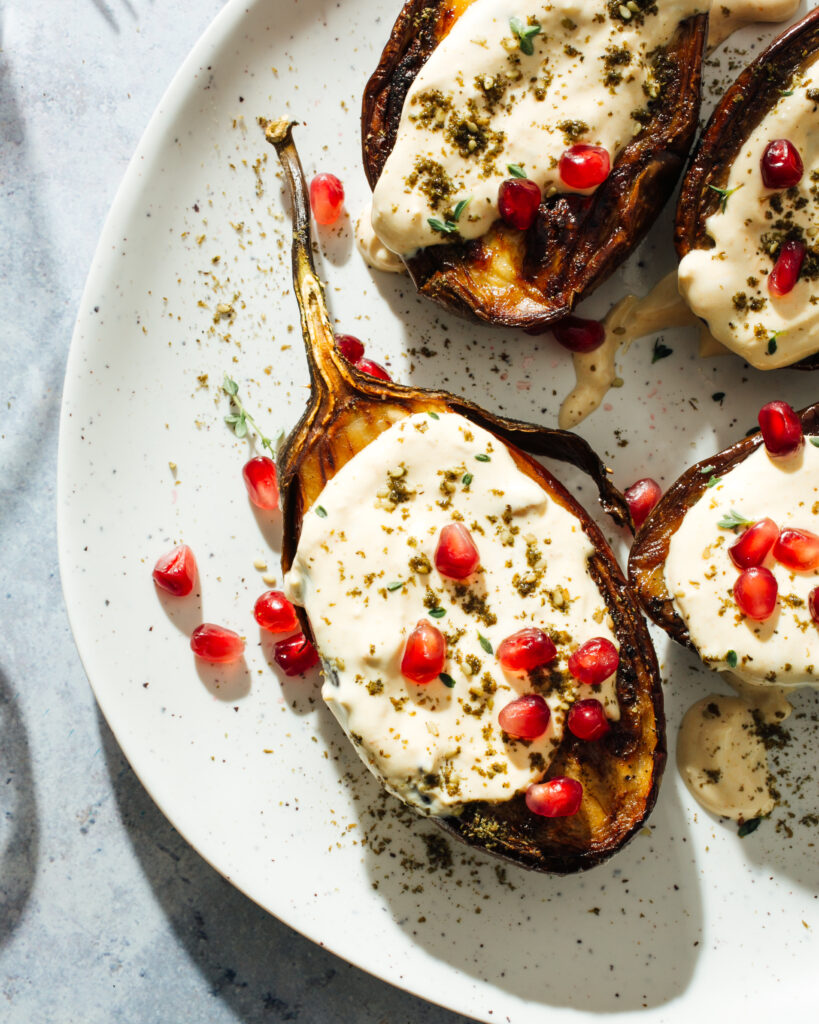 Photo by Mackenzie Smith Kelley. Recipe written by Yotam Ottolenghi, shared by Mackenzie.
Photo by Mackenzie Smith Kelley. Recipe written by Yotam Ottolenghi, shared by Mackenzie.
Ottolenghi's Eggplant with Garlicky Buttermilk Yogurt Sauce This recipe for slow-roasted eggplants and a garlicky buttermilk yogurt sauce is originally from Yotam Ottolenghi’s first cookbook, “Plenty: Vibrant Vegetable Recipes”. I have been making a similar version of this perfect-way-to-cook-an-eggplant since I first read this recipe back when the book was published in 2010. The original recipe calls for 2 large, long eggplants, but I have found that roasting smaller ones works just as well, though the cooking time should be adjusted based on the size and amount of eggplants you are roasting (smaller or less, reduce cooking time). The amount of olive oil may seem excessive, and as someone who has made this recipe for years, I had made it with less than ⅓ of a cup, and it still works, though the eggplant won't be quite as silky from all that olive oil. If you don’t have as much olive oil as the recipe calls for, do your best to make sure the incisions on the eggplant are absorbing some of the oil.
The buttermilk yogurt sauce is truly perfect as-is, but as a self-proclaimed lemon-head, I have convinced myself over the years that a teaspoon or two of lemon zest belongs there, too. And recently, when I didn’t have a single clove of fresh garlic in my kitchen (gasp, I know), I stirred in a spoonful of roasted garlic achaar, which satisfied the need for garlic and brought even more flavor to the table.
Ingredients
5-6 small eggplants or 2 large, long ones
1/3 cup olive oil
1 1/2 tsp lemon thyme leaves, plus a few whole sprigs to garnish
Maldon sea salt and black pepper
1 pomegranate
1 tsp za'atar
Sauce:
9 tbsp buttermilk
1/2 cup Greek yogurt
1 1/2 tbsp olive oil, plus a drizzle to finish
1 small garlic clove, crushed
1-2 teaspoons of lemon zest
Pinch of salt
Preparation
Preheat the oven to 200°F. Cut the eggplants in half lengthways, cutting straight through the green stalk (the stalk is for the look; don't eat it). Use a small sharp knife to make three or four parallel incisions in the cut side of each eggplant half, without cutting through to the skin. Repeat at a 45-degree angle to get a diamond-shaped pattern.
Place the eggplant halves, cut-side up, on a baking sheet lined with parchment paper. Brush them with olive oil—keep on brushing until all of the oil has been absorbed by the flesh. Sprinkle with the lemon thyme leaves and some salt and pepper. Roast for 35 to 40 minutes, at which point the flesh should be soft, flavorful and nicely browned. Remove from the oven and allow to cool down completely
While the eggplants are in the oven, cut the pomegranate into two horizontally. Hold one half over a bowl, with the cut side against your palm, and use the back of a wooden spoon or a rolling pin to gently knock on the pomegranate skin. Continue beating with increasing power until the seeds start coming out naturally and falling through your fingers into the bowl. Once all are there, sift through the seeds to remove any bits of white skin or membrane.
To make the sauce. Whisk together all of the ingredients. Taste for seasoning, then keep cold until needed.
To serve, spoon plenty of buttermilk sauce over the eggplant halves without covering the stalks. Sprinkle za'atar and plenty of pomegranate seeds on top and garnish with lemon thyme. Finish with a drizzle of olive oil.
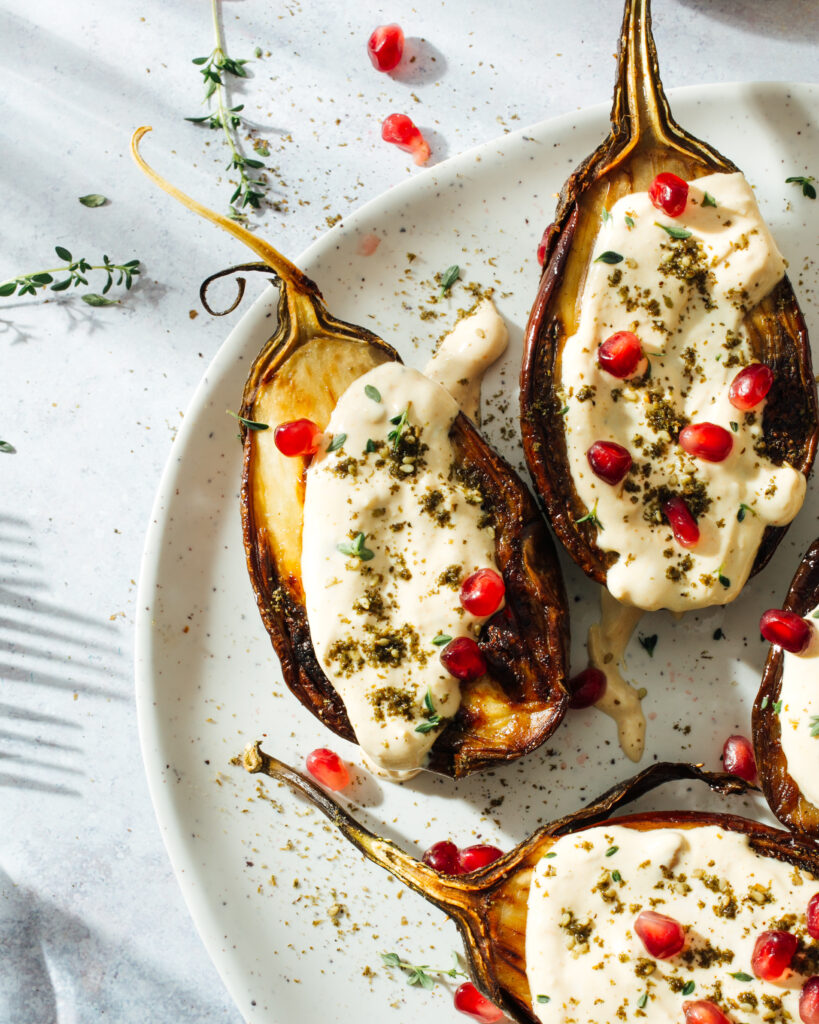 Photo by Mackenzie Smith.
Photo by Mackenzie Smith.CSA BOX CONTENTS WEEK SEPT 14
09/14/20 — Ada Broussard
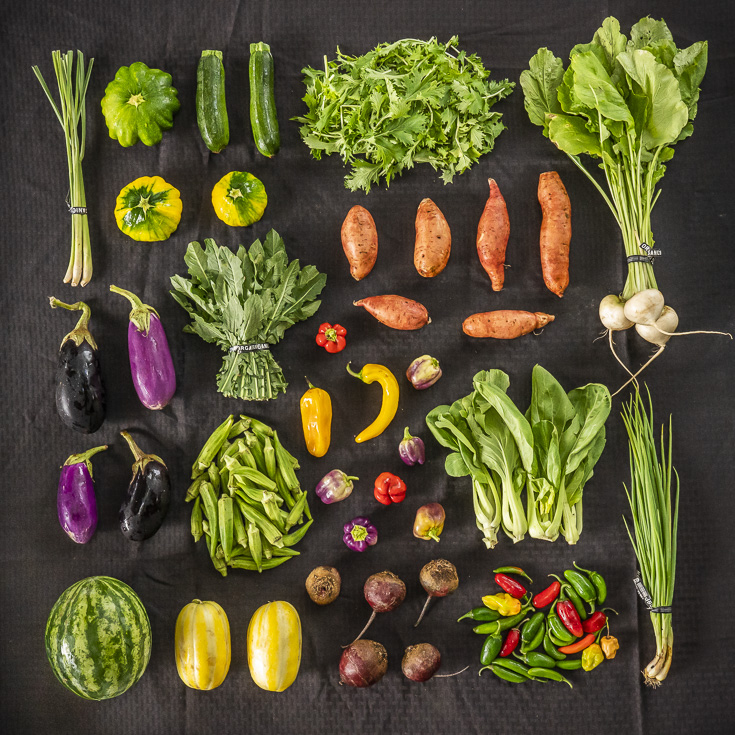 CSA Box Contents Week of Sept 14th
CSA Box Contents Week of Sept 14th
Large: Beets, Bok Choy, Cucumber, Farmers' Choice of Greens, Mizuna, Herb, Melon, Multiplying Onion, Hot Pepper Medley, Sweet Potato, Summer Squash, Turnip
Medium: Beets, Baby Bok Choy, Herb, Okra, Multiplying Onion, Hot Pepper Medley, Summer Squash, Turnip
Small: Bok Choy, Eggplant, Farmer's Choice of Greens, Herb, Sweet Peppers, Sweet Potato, Turnip
Individual: Baby Bok Choy, Farmer's Choice of Greens, Sweet Potato, Radish
HOME SCHOOLIN' WITH JBG
09/11/20 — Ada Broussard
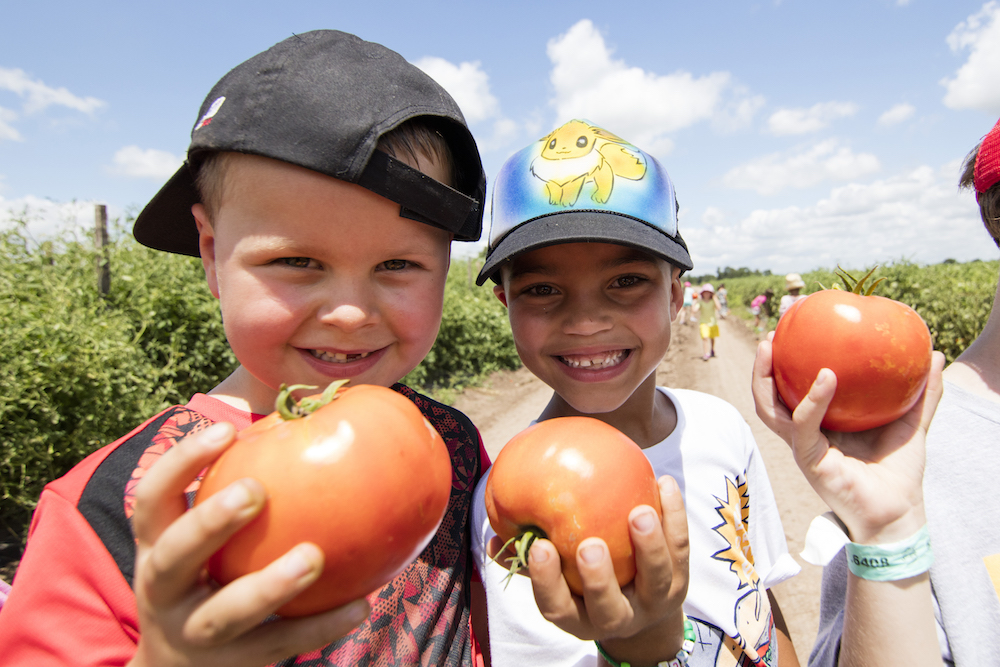 Once upon a time, we hosted an actual field trip to the farm. Photo by Casey Degman.
Once upon a time, we hosted an actual field trip to the farm. Photo by Casey Degman.
This is certainly a bizarre back to school season, to say the least. Are you feeling stretched for time as you adjust to this new school year? If so, check out the very simple meal plan we put together featuring late summer veggies. Feeling the need to provide some at-home learning opportunities for your littles? Even as adults, we’re constantly learning here on the farm, and there is no reason you can’t draw some inspiration from the wonders of the farm-life, too.
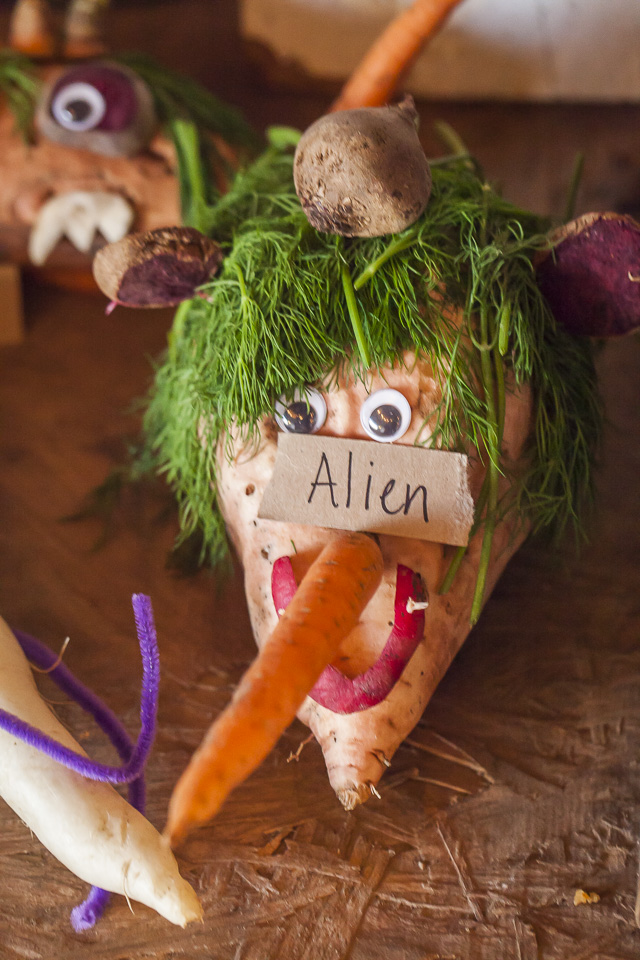 We fully endorse a bit of play with your food.
We fully endorse a bit of play with your food.
The number of free farm and ag-related educational materials on the internet is truly stunning. If you’re a seasoned home-school teacher, maybe you already have your favorite resources that cover farm-related topics. But we approached this idea as many of you might be - as a complete novice. And really, it was somewhat overwhelming. So, if you’re a parent reading this, we first and foremost applaud you, and secondly, we hope you are cutting yourself a big break. And maybe a slice of sweet potato pie ?
Without further ado, a JBG lesson plan:
SCIENCE: Is there any better illustration of the wonders of science and prowess of mother nature than planting a seed and having it turn into a vegetable-producing plant? If you have your own garden, you already know what to do. And if you’ve never grown a thing in your life, you can get started with this powerful science lesson using only a couple of pots, some soil, and some cool-weather vegetable seeds.
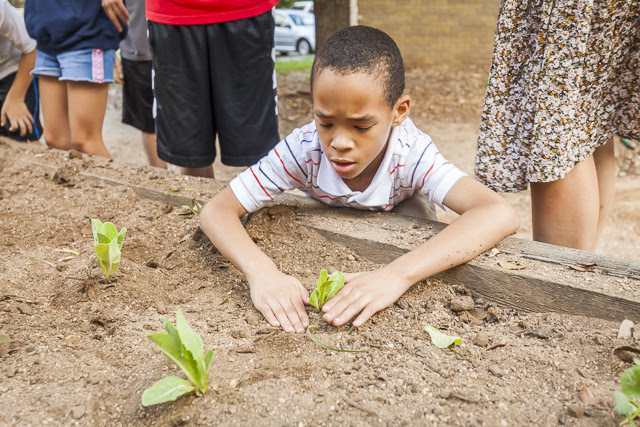 Lettuce is a great vegetable to plant in a teaching garden. It's easy to grow and easy to prepare.. just add ranch! Photo by Scott David Gordon.
Lettuce is a great vegetable to plant in a teaching garden. It's easy to grow and easy to prepare.. just add ranch! Photo by Scott David Gordon.
ALL AGES: When deciding what to plant in your garden, follow your farmers’ lead and use this Travis County seeding chart. Studying this chart with your kiddo is the perfect introduction to seasonality. If you checkout the chart, you’ll notice that now is the time to plant many fall vegetables. Germination is a vocabulary word worth teaching, but if you want to skip the seed portion of this lesson, most local gardening centers have cool-weather transplants that are ready to plop into the ground.
PRESCHOOL AND UP: To lay the groundwork for your gardening lesson, we enthusiastically recommend the book How Groundhog’s Garden Grew by Lynn Cherry. In this book, Little Groundhog learns how to grow his own vegetables (and stop eating the vegetables from his neighbor’s garden). Together with his animal friends, Little Groundhog leans about planting, tending to, harvesting, and even cooking a cornucopia of vegetables. You can watch a read-along of this book here. The illustrations are beautiful! Thanks to Growing Minds (an online educational resource) for suggesting this book. Their website has a ton of lesson plan ideas, also.
 We LOVE the illustrations in this book! Checkout the read along on Youtube!
We LOVE the illustrations in this book! Checkout the read along on Youtube!
GRADES 2-5: The folks at Whole Kids Foundation have put together this (free!) and comprehensive set of lessons to accompany a school garden. There are over 35 creative and cross-curricular lesson plans geared for grades Pre-K through 5 in this resource, and if you’re growing anything at home, this is an incredible collection of enrichment opportunities. One of our favorite lessons is on page 30 and is titled “Seed Packets, Things to Know Before You Grow”. This one hit close to home. If you intend to plant some seeds in the next couple of weeks, follow this lesson plan (and accompanying worksheets) to have your child understand things like germination rates, planting depth, planting spacing, days to maturity, and more. The lesson plan has great suggestions on adding some math into the experience… specifically some of the same calculations that professional farmers do all the time: If beets are planted 3 inches apart and my row is 90 feet long, how many beets will fit in a row? What about if there are two rows per bed? One bunch of beets equals three beets. How many beds would it take to fill 1,000 CSA shares with 1 bunch of beets each? And if I wanted to put the beets in CSA boxes on November 9th, what day would I have to plant the beets? You get the idea.
We can’t say enough about the Whole Kids Foundation resource; it’s one of our favorites that we came across. Another lesson that we really liked can be found on page 122: “A Food Critic in the Garden”. This plan is complete with a formidable vocabulary list for the next generation of food critics and food writers!
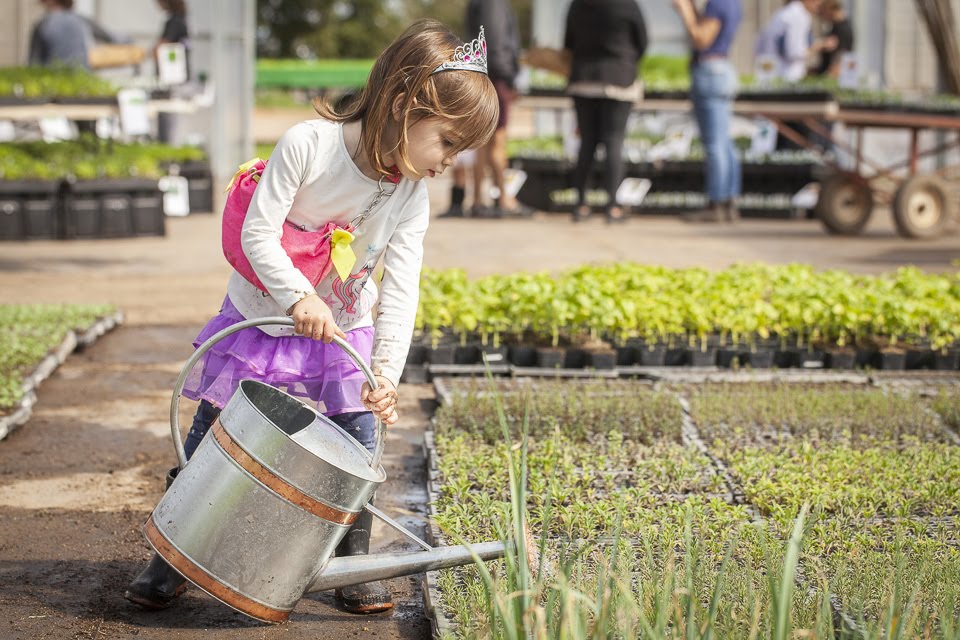
HISTORY: When researching varieties of seed to plant and try out at the farm, we inevitably end up doing a lot of historical research. Not only do particular varieties of a vegetable usually have an interesting origin story, but the domestication of the veggies themselves is the perfect portal to lessons in world history, trade, and the migration of peoples across our globe.
GRADES 5 AND UP: Have your kiddos help you unpack your next CSA share, and encourage them identify one (or all!) of the unfamiliar vegetables in the box. Research a vegetable’s history. When was it domesticated, and how did it get to North America? What other foods were transported with this vegetable and how did the vegetable change as it moved around? What are some ways to prepare the vegetable in the region where it originates? Page 175 of this PDF has a lesson plan titled “Food From Around the World” including a worksheet that makes this large topic a bit more digestible.
MATH: What better way to brush up on your math skills than to do some cooking? Both baking and pickling would lend themselves well to lessons on conversions, fractions, telling time and even shapes.
 Hectors beet muffins, pre-bake.
Hectors beet muffins, pre-bake.
ANY GRADE? Here is a great recipe for Hector’s Beet Muffins from the JBG Recipe Archive. The ingredients in this recipe are listed in milliliters, making this a great opportunity to practice conversions to more familiar teaspoon and tablespoon measurements.
No time to whip up some beet muffins? Here is a cute, seemingly-Italian (cartoon) chef named Tiggly who is teaching preschoolers some addition while making a kiwi and salami soup.
ART: We don’t see any reason you shouldn’t play a bit with your food. Before you store your farmers’ market haul or CSA box contents in the fridge, work with your child to create a large mandala-like design with all of the vegetables.
ALL AGES… ADULTS, TOO!: Spread your vegetables out on a large table cloth or sheet, painting patterns with your colorful haul. Consider getting some dinner prep completed and have our child chop some of your veggies into different shapes and sizes, revealing the vibrant colors inside. Pretend like you’re a farm photographer and get up high to capture the image (and please, email us the pic if you do!). Or, take this veggie play in a different direction and make veggie monsters. Vegetables, toothpicks, and maybe some wooden skewers are about all you need for this project. Set a station up (with some supervision if a knife is involved) and we promise your kiddo will know what to do. Here are some photos of JBG veggie monsters from seasons past for some inspiration. https://jbgorganic.com/blog/2018/11/jbg-fall-open-house-thanks-recap/ Bonus points if googly eyes are involved!
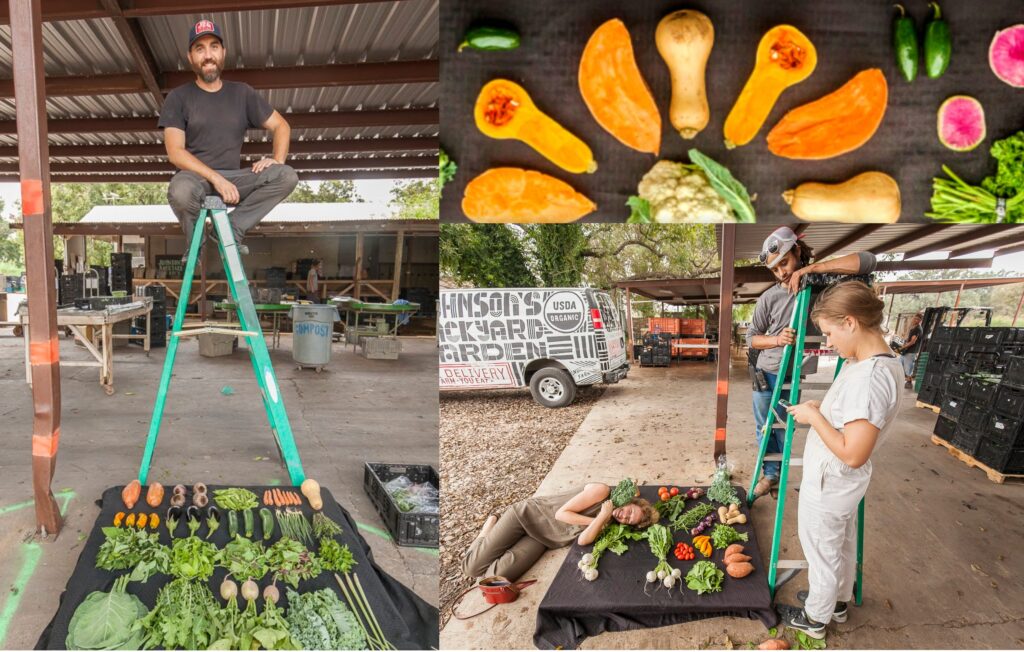 We certainly sneak in a bit of play with our work.
We certainly sneak in a bit of play with our work.
FIELD TRIP: Did you know that one of our Community Pickup Locations for our CSA boxes is actually at our Garfield (River Road) farm? This pickup is on Fridays from 11am to 2pm, and when you scoop up your box at the farm you’re more than welcome to stretch your legs and meander about the fields. Scout the fields, and get excited for upcoming crops! Adam, one of Garfield team members, is usually around to direct you a luscious patch of herbs that you’re welcome to pick a a bundle from. There is a mighty team of tractors and a motley group of trucks always in motion and there to behold. If you’d like to field trip out to the farm for your CSA share one week, simply shoot Faith an email a few days before your regularly scheduled box and she can make the switch. You can email Faith at farm@jbgorganic.com Protip: Wear mud boots if it’s been a rainy week, and make sure your GPS is directing you to our farm in Garfield - Google may lead you to our other location!
 Scoop up your CSA box and enjoy the wide open spaces our Garfield farm has to offer! Photo by Scott David Gordon.
Scoop up your CSA box and enjoy the wide open spaces our Garfield farm has to offer! Photo by Scott David Gordon.
ROSEMARY FONDANT SWEET POTATOES
09/09/20 — Ada Broussard
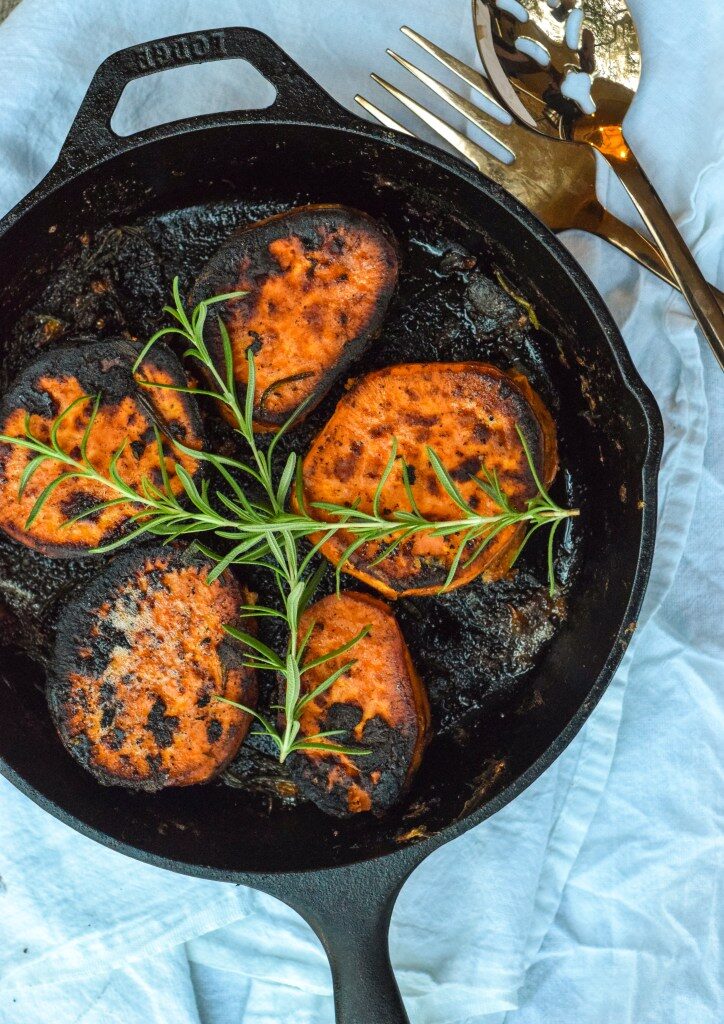 Photos and recipe by: The Migoni Kitchen
Photos and recipe by: The Migoni Kitchen
Fall is officially here! Time for all of the pumpkin, sweet potato, and squash dishes your heart desires. We love sweet potatoes, but like to mix things up in how we prepare them. Instead of simply roasting them or mashing them, we love these rosemary fondant sweet potatoes. They have a soft inside, but a crispy exterior, giving you the best of both worlds.
Fondant potatoes are a French preparation that involve searing the potatoes in butter, and then allowing them to simmer in broth and herbs to cook through on the inside. It takes a bit more effort than just simply roasting them, but is worth it in the end. You can absolutely prepare regular potatoes this way as well, but we love the flavor when done with sweet potatoes. We used chicken broth, rosemary, and garlic to infuse our potatoes, but you can use any flavors or herbs that you like. It’s a great side dish to impress guests for a dinner party and can be made ahead!
Ingredients:
- 1-2 Large Sweet Potatoes Peeled and sliced into 2 inch rounds
- 3 Tablespoons Unsalted Butter
- 2 Cups Chicken Stock
- 3 Cloves Garlic
- 3 Sprigs Fresh Rosemary
- Salt and Pepper To Taste
Instructions:
- Heat a large non-stick pan over medium-high heat and add in the butter.
- Once the butter begins to bubble, add in your sweet potato rounds and brown on each side for 3-4 minutes. While the sweet potatoes are browning, season with salt and pepper.
- Add garlic and half of the rosemary in between the sweet potatoes and allow to cook for 1 minute.
- Next, lower the heat and add the broth to cover about ¾ of the potatoes. Allow to simmer and reduce until the liquid is nearly absorbed, about 25 minutes.
- Once the liquid has absorbed, you'll notice the potatoes start to caramelize. Once they take on a darker color, flip them and allow to brown on the other side.
- Remove from heat and top with remaining rosemary. Add additional salt and pepper to taste.
CSA BOX CONTENTS WEEK OF SEPT 7TH
09/07/20 — Scott
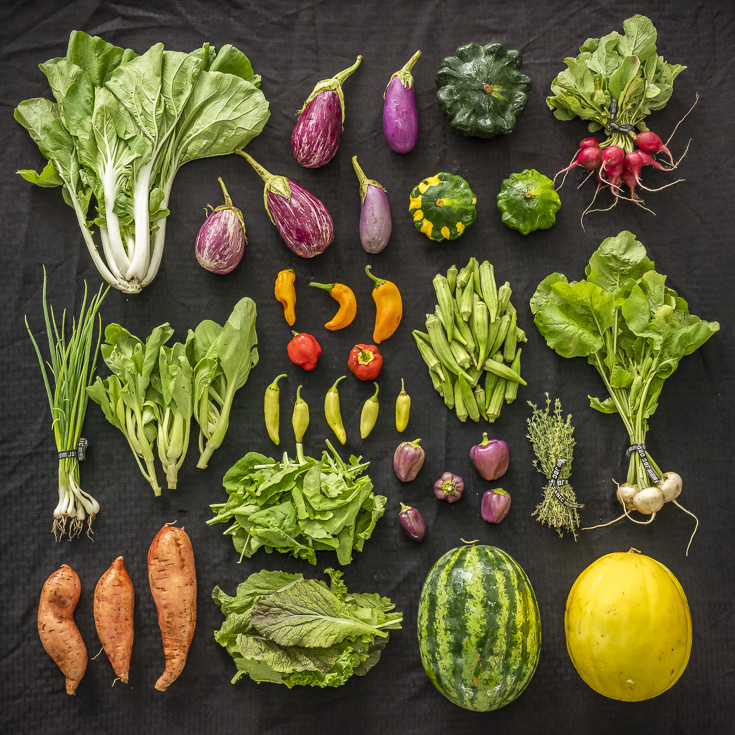 CSA Box Contents Week of Sept 7th
CSA Box Contents Week of Sept 7th
Large Box
Beets
Bok Choy
Cucumber
Greens, Farmers Choice
Greens, Mizuna
Herb
Melon
Onion, Multiplying
Pepper, Hot Medley
Potato, Sweet
Summer Squash
Turnip
Beets
Bok Choy
Cucumber
Greens, Farmers Choice
Greens, Mizuna
Herb
Melon
Onion, Multiplying
Pepper, Hot Medley
Potato, Sweet
Summer Squash
Turnip
Medium Box
Beets
Bok Choy, Baby
Eggplant
Greens, Farmers Choice
Herb
Okra
Onion, Multiplying
Pepper, Hot Medley
Summer Squash
Turnip
Beets
Bok Choy, Baby
Eggplant
Greens, Farmers Choice
Herb
Okra
Onion, Multiplying
Pepper, Hot Medley
Summer Squash
Turnip
Small Box
Bok Choy
Eggplant
Greens, Farmers Choice
Herb
Pepper, Sweet
Potato, Sweet
Turnip
Bok Choy
Eggplant
Greens, Farmers Choice
Herb
Pepper, Sweet
Potato, Sweet
Turnip
Individual Box
Bok Choy, Baby
Greens, Farmers Choice
Pepper, Sweet
Potato, Sweet
Radish
Bok Choy, Baby
Greens, Farmers Choice
Pepper, Sweet
Potato, Sweet
Radish
PHOTOS FROM THE FARM: 9.4.2020
09/04/20 — Ada Broussard
This week Scott caught up with our Farmer's Market Crew at the Mueller Farmers Market. During certain parts of the year, our booth is setup under the old airport hanger, and we're certainly grateful for the added shade!
![]() Both our Small and Individual CSA shares are packed in these red boxes. Here is a healthy stack, ready for pickup! Photo by Scott David Gordon.
Both our Small and Individual CSA shares are packed in these red boxes. Here is a healthy stack, ready for pickup! Photo by Scott David Gordon.
![]() The Mueller market is on Sundays from 10am-2pm.
The Mueller market is on Sundays from 10am-2pm.
![]() We are still operating our booth following our COVID-19 protocol: customers are not allowed to browse our stall, and instead they "order" what they'd like from our register. In this photo you see Devon making up a customer's order! Photo by Scott David Gordon.
We are still operating our booth following our COVID-19 protocol: customers are not allowed to browse our stall, and instead they "order" what they'd like from our register. In this photo you see Devon making up a customer's order! Photo by Scott David Gordon.
![]() Photo by Scott David Gordon.
Photo by Scott David Gordon.
![]() What a colorful bounty this week! Photo by Scott David Gordon.
What a colorful bounty this week! Photo by Scott David Gordon.
![]() Mint, please! Photo by Scott David Gordon.
Mint, please! Photo by Scott David Gordon.
![]() Bok choy and eggplant, too. Wonder what he's cooking? Photo by Scott David Gordon.
Bok choy and eggplant, too. Wonder what he's cooking? Photo by Scott David Gordon.
![]() Don't forget to bring a bag so you can leave your CSA box! Photo by Scott David Gordon.
Don't forget to bring a bag so you can leave your CSA box! Photo by Scott David Gordon.
![]() Scott caught in the act! Photo by Scott David Gordon.
Scott caught in the act! Photo by Scott David Gordon.
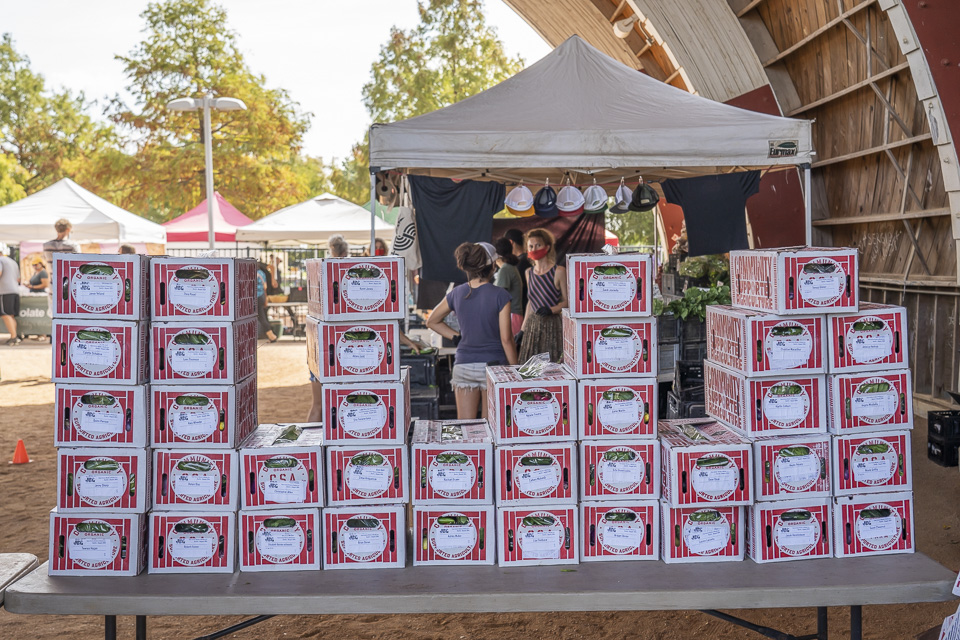 Both our Small and Individual CSA shares are packed in these red boxes. Here is a healthy stack, ready for pickup! Photo by Scott David Gordon.
Both our Small and Individual CSA shares are packed in these red boxes. Here is a healthy stack, ready for pickup! Photo by Scott David Gordon.
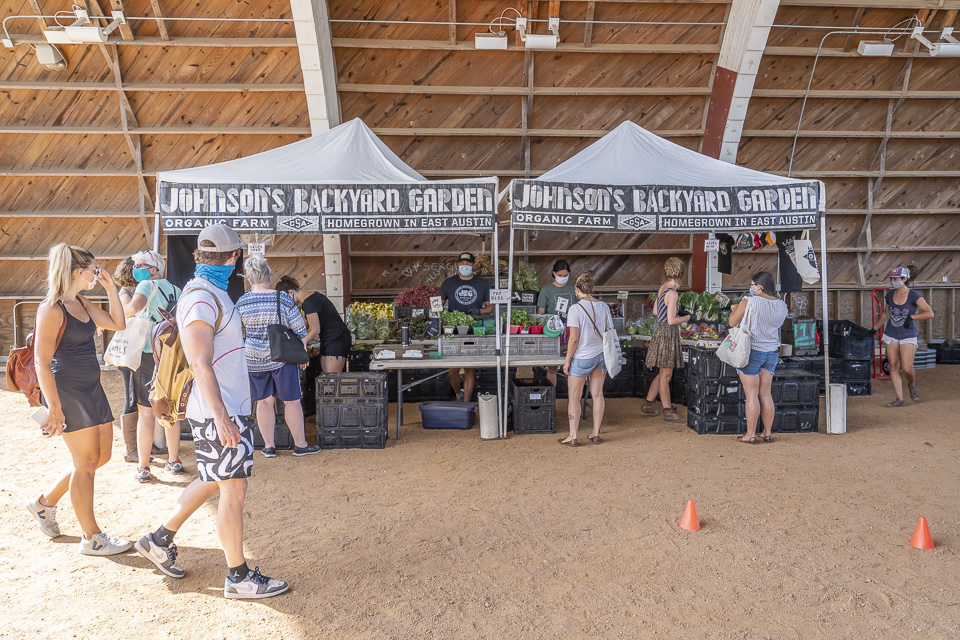 The Mueller market is on Sundays from 10am-2pm.
The Mueller market is on Sundays from 10am-2pm.
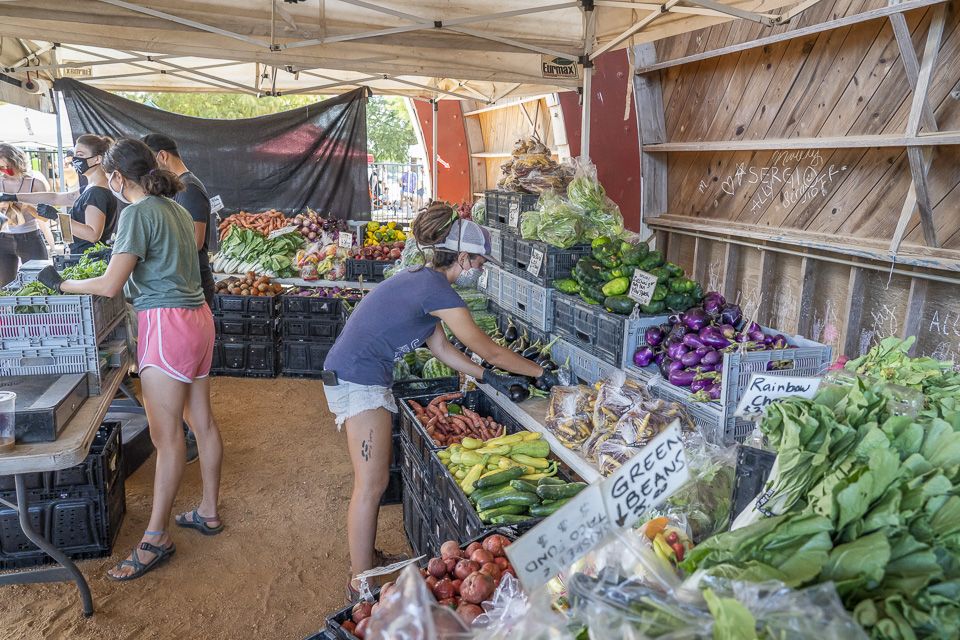 We are still operating our booth following our COVID-19 protocol: customers are not allowed to browse our stall, and instead they "order" what they'd like from our register. In this photo you see Devon making up a customer's order! Photo by Scott David Gordon.
We are still operating our booth following our COVID-19 protocol: customers are not allowed to browse our stall, and instead they "order" what they'd like from our register. In this photo you see Devon making up a customer's order! Photo by Scott David Gordon.
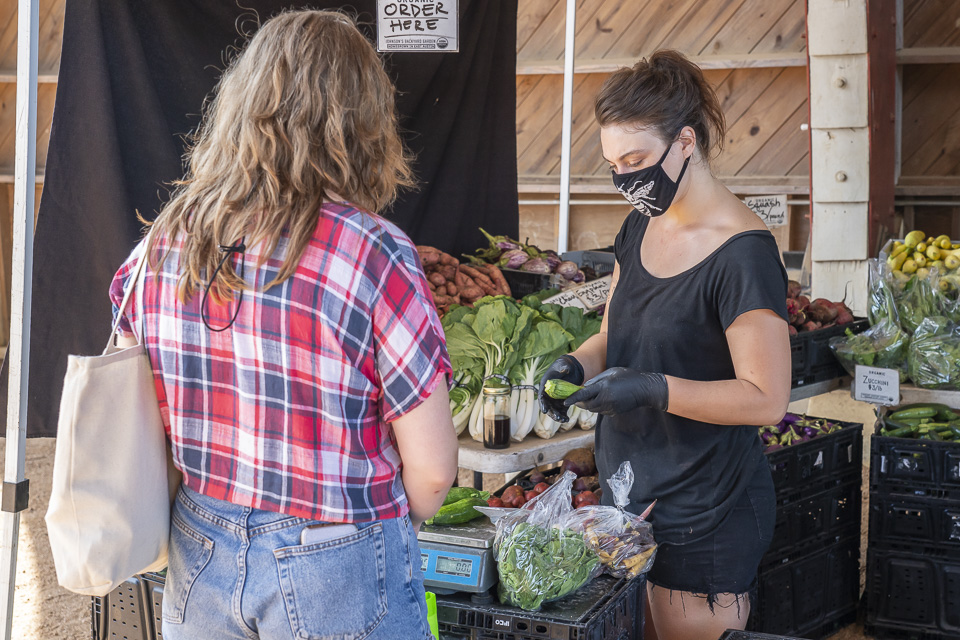 Photo by Scott David Gordon.
Photo by Scott David Gordon.
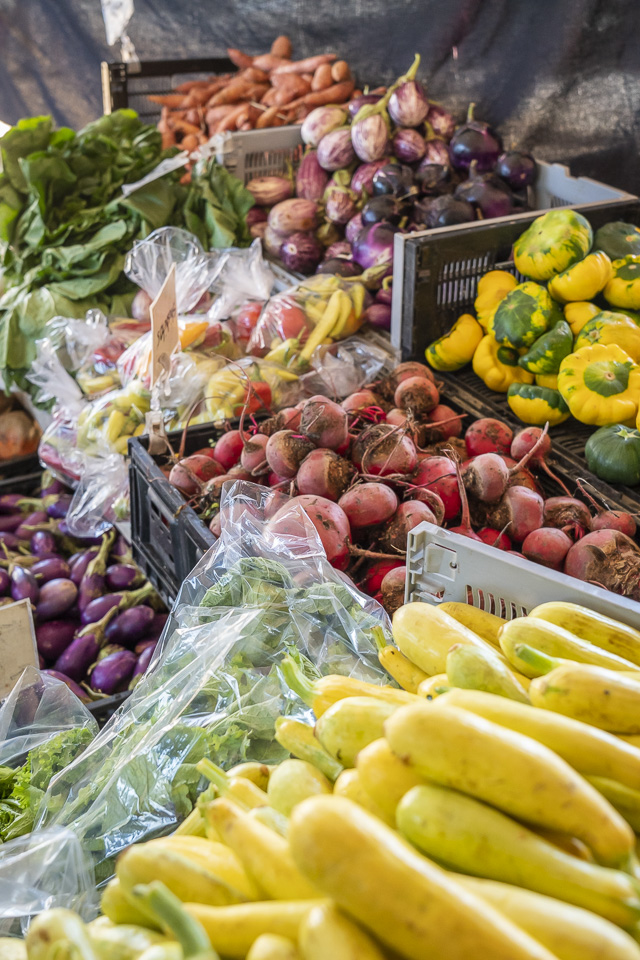 What a colorful bounty this week! Photo by Scott David Gordon.
What a colorful bounty this week! Photo by Scott David Gordon.
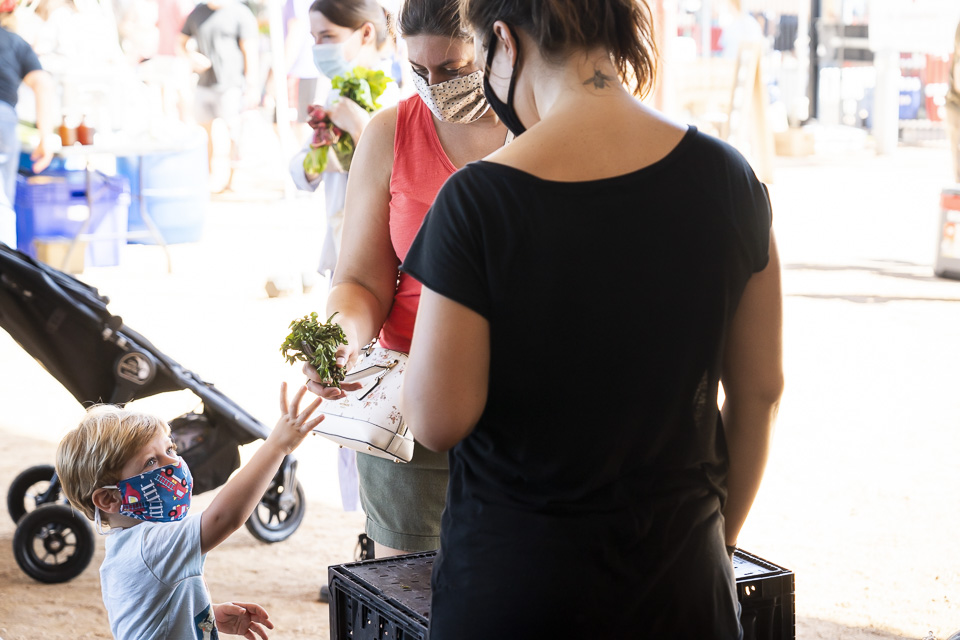 Mint, please! Photo by Scott David Gordon.
Mint, please! Photo by Scott David Gordon.
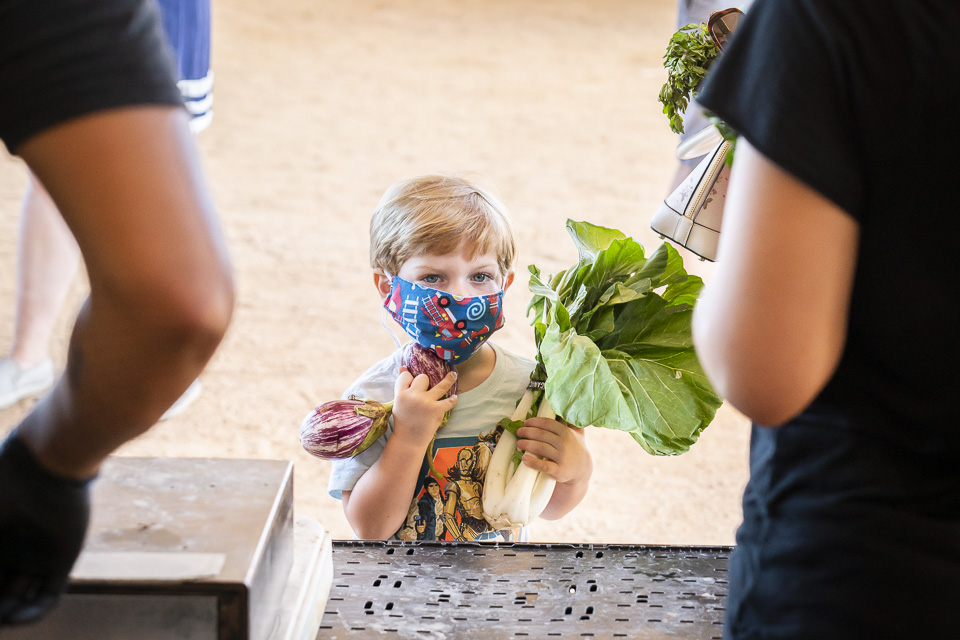 Bok choy and eggplant, too. Wonder what he's cooking? Photo by Scott David Gordon.
Bok choy and eggplant, too. Wonder what he's cooking? Photo by Scott David Gordon.
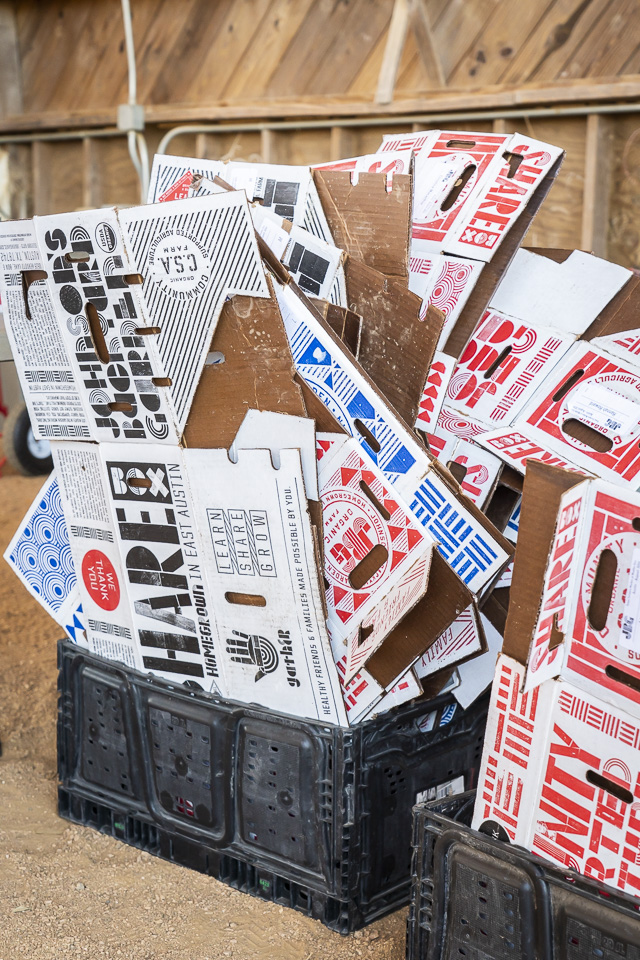 Don't forget to bring a bag so you can leave your CSA box! Photo by Scott David Gordon.
Don't forget to bring a bag so you can leave your CSA box! Photo by Scott David Gordon.
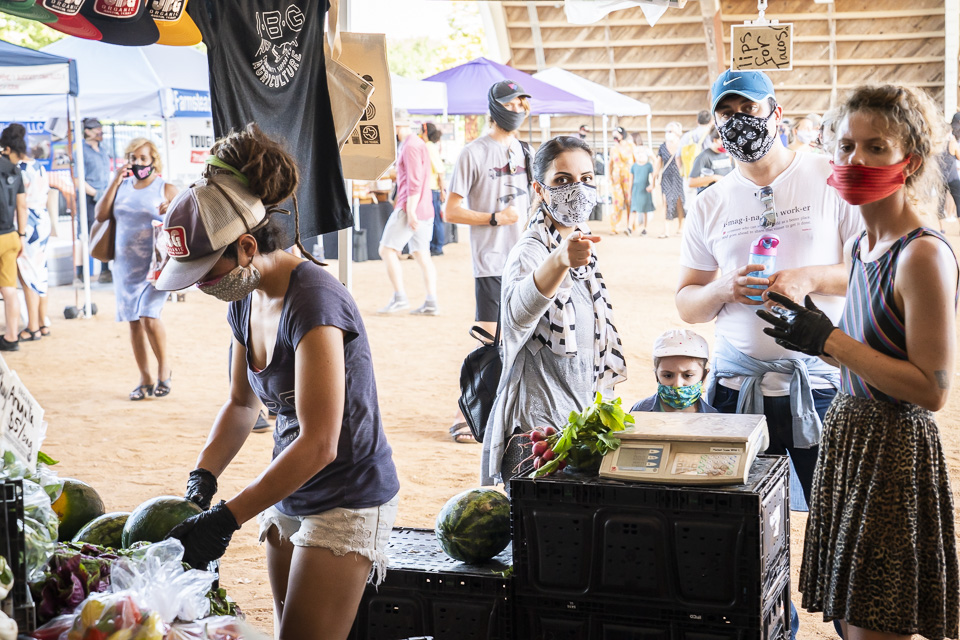 Scott caught in the act! Photo by Scott David Gordon.
Scott caught in the act! Photo by Scott David Gordon.






 0 ITEMS IN CART
0 ITEMS IN CART 

